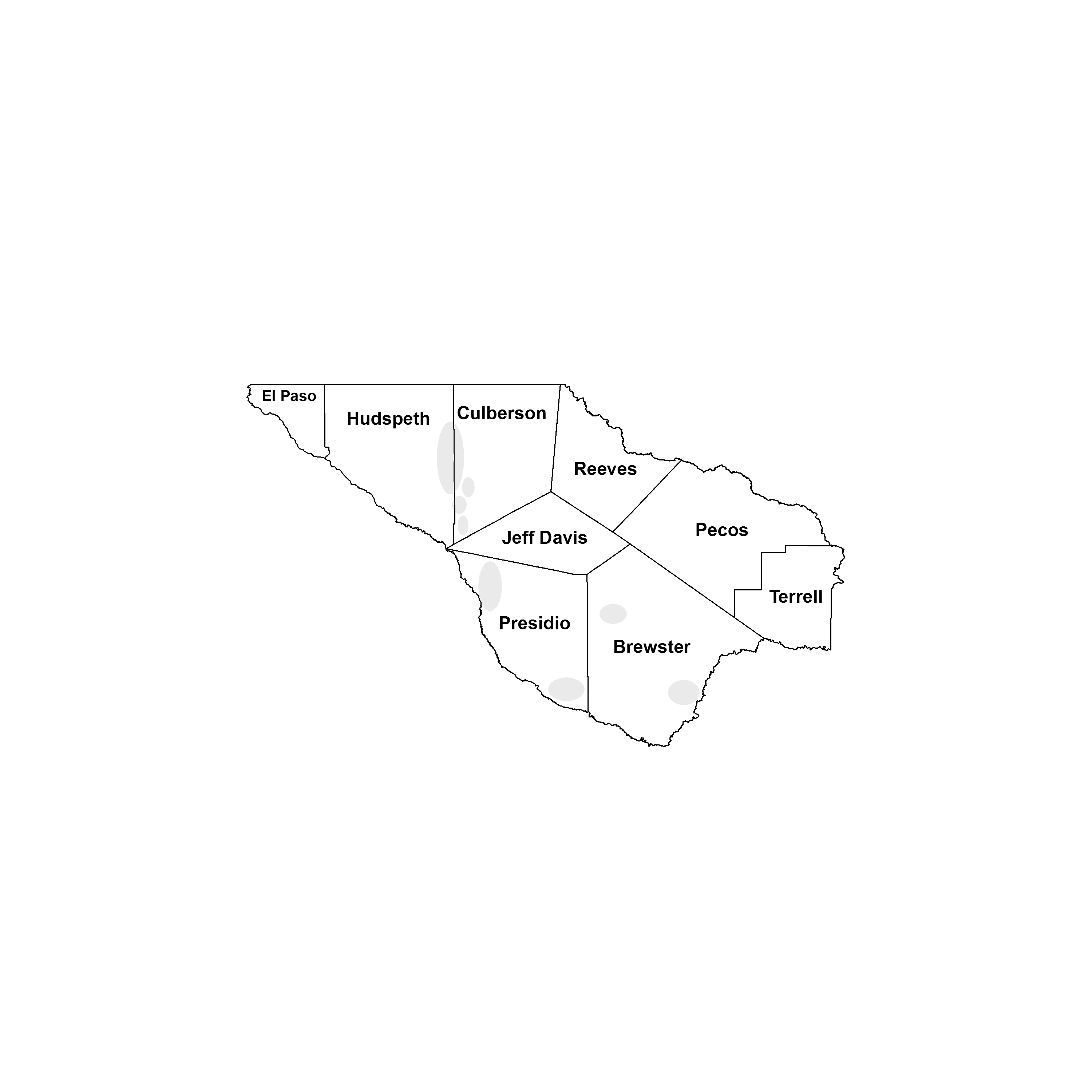BIGHORN SHEEP
Ovis canadensis Shaw 1804
Order Artiodactyla : Family Bovidae
DESCRIPTION. A large, light-brown sheep with heavy, tapering, curled brown horns in males (horns much smaller and less curled in females) and conspicuous white rump patch; pelage hairy, not woolly; four black hooves on each foot; tail short; mammae two. Dental formula: I 0/3, C 0/1, Pm 3/3, M 3/3 × 2 = 32 (lower canine is shaped like an incisor). Averages for external measurements: of males, total length, 1,763 mm; tail, 107 mm; hind foot, 439 mm; of females, 1,431-107-407 mm. Weight of males, 75–150 kg; of females, 45–65 kg.

DISTRIBUTION. Formerly ranged throughout the isolated mountain ranges of the Trans-Pecos; however, native populations are now extirpated. The last native bighorn sheep were seen in the Sierra Diablo in 1959, when the total population was estimated at 14. Recent introductions of bighorn sheep in the Sierra Diablo–Baylor–Beach Mountains complex, the Sierra Vieja Mountains, the Van Horn Mountains, Elephant Mountain Wildlife Management Area, Black Gap Wildlife Management Area, and Big Bend National Park have resulted in small, wild populations in those areas.

SUBSPECIES. The native subspecies was O. c. mexicana, but other subspecies have been introduced, including O. c. canadensis and O. c. nelsoni.
HABITS. In general, bighorn sheep are inhabitants of rough, rocky, mountainous terrain. They are not forest dwellers but prefer bluffs and steep slopes where the vegetation is sparse and the view unobstructed.
Beds are conspicuous indicators of the presence of sheep. Two distinct types are utilized. The day bed, used during midday siestas, is a temporary affair constructed when and where the individual sheep decides to rest. Usually each adult animal, particularly among the rams, excavates a shallow depression by executing three or four pawing scratches with each forefoot before lying down. Lambs and yearlings usually omit the pawing activity. The night beds are more elaborate structures. They are usually situated on steep, rocky slopes, on top of rocky rims, or on a slope between two bluffs. In such places the sheep receive adequate protection, for they have an unobstructed view in all directions except uphill, from which direction the approach of a predator would be signaled by rolling stones. The animals tend to bunch together at night. Individual beds are ovoid in shape with the long axis on the contour of the slope. Beds are typically 7–10 cm in depth, about 75 cm in length, and 60 cm in width. No bedding of any sort is utilized; the animals lie on the bare earth. Beds in constant use are rimmed with piles of feces and strong with the odor of urine.
The food of bighorn sheep depends on availability and season. In western Texas, deer brush, sotol, and ocotillo were utilized extensively by bighorns. Vernon Bailey reported them as feeding on mountain mahogany, Mexican tea, trumpet flower, mock orange, prickly pear, wild onions, and penstemon. The fruits of datil yucca and prickly pear are especially choice foods in the desert areas. Bighorns rarely need water. Apparently, they derive sufficient water from the green and succulent vegetation on which they feed.
The breeding season begins in November and continues for a period of approximately 6 weeks. The rams do considerable fighting in this period, and usually the larger and stronger ones prevent the weaker ones from mating. The bighorn ram does not assemble and guard a harem but moves from flock to flock seeking ewes that are ready to mate. Ewes become sexually mature at 2.5 years and give birth to their first lambs at 3 years of age. Rams <3 years of age appear to take little, if any, active part in breeding activities. The gestation period is approximately 180 days. The first lambs are born in mid-May, with others appearing until about mid-June. Usually, only one lamb is produced, but twins are not infrequent. The lambs are weak and helpless at first, but they develop rapidly and by the age of 1 week are able to follow the ewes about with ease.
Age in bighorn sheep can be estimated by examination of the teeth. The formula at birth is I 0/3, C 0/1, Pm 2/2, M 0/0 (milk dentition); at 8 months, I 0/3, C 0/1, Pm 3/3, M 1/1 (molars permanent); at 15–18 months, I 0/3, C 0/1, Pm 3/3, M 2/2 (molars permanent); at 24 months, first (middle) incisor is shed and replaced by permanent tooth; at 36 months, first two premolars are shed and replaced by permanent teeth; at 42 months, third molars are fully erupted, second milk incisor replaced, and last premolars shed and replaced; and at 48 months, full set of permanent teeth are attained.
POPULATION STATUS. Rare. At one time bighorn sheep were widespread in Trans-Pecos Texas, but the advance of civilization and the inroads of domestic sheep on the range of the wild animals led to a steady decline of the bighorn population. In spite of laws affording full protection to the sheep, they continued to decline in numbers. Today the native population is considered extinct. However, the TPWD has established wild-trapped sheep from other states and its own captive breeding programs in several Trans-Pecos mountain ranges. Currently, there are an estimated 1,500 individuals in 10 mountain ranges throughout the Trans-Pecos; it appears that the number of individuals and their distribution are expanding.
CONSERVATION STATUS. The IUCN lists the bighorn sheep's status as least concern, and it does not appear on the federal or state lists of concerned species. Although it has taken time and has been difficult, TPWD's efforts to establish breeding populations in several mountain ranges in the Trans-Pecos area are beginning to come to fruition. Populations now have a foothold in the Sierra Diablo, Sierra Vieja, Baylor, Beach, and Van Horn Mountain complexes, including the Elephant Mountain Wildlife Management Area, Black Gap Wildlife Management Area, and Big Bend Ranch State Park.
From The Mammals of Texas, Seventh Edition by David J. Schmidly and Robert D. Bradley, copyright © 1994, 2004, 2016. Courtesy of the University of Texas Press.
Natural Science Research Laboratory
-
Address
Museum of Texas Tech University, 3301 4th street, Lubbock, TX 79409 -
Phone
806.742.2486 -
Email
nsrl.museum@ttu.edu

